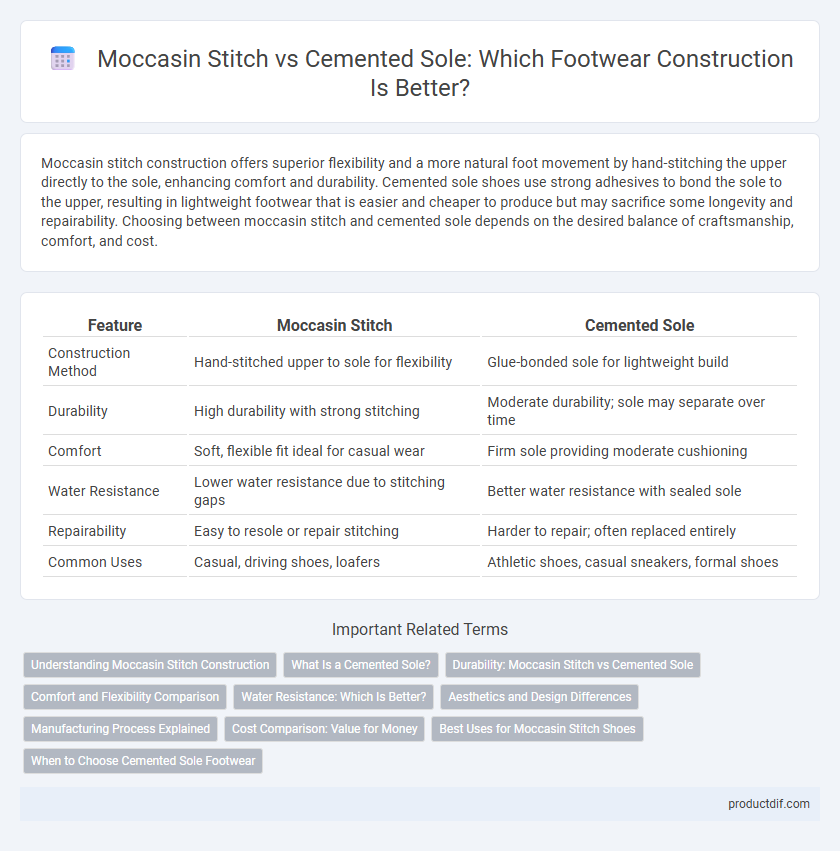Moccasin stitch construction offers superior flexibility and a more natural foot movement by hand-stitching the upper directly to the sole, enhancing comfort and durability. Cemented sole shoes use strong adhesives to bond the sole to the upper, resulting in lightweight footwear that is easier and cheaper to produce but may sacrifice some longevity and repairability. Choosing between moccasin stitch and cemented sole depends on the desired balance of craftsmanship, comfort, and cost.
Table of Comparison
| Feature | Moccasin Stitch | Cemented Sole |
|---|---|---|
| Construction Method | Hand-stitched upper to sole for flexibility | Glue-bonded sole for lightweight build |
| Durability | High durability with strong stitching | Moderate durability; sole may separate over time |
| Comfort | Soft, flexible fit ideal for casual wear | Firm sole providing moderate cushioning |
| Water Resistance | Lower water resistance due to stitching gaps | Better water resistance with sealed sole |
| Repairability | Easy to resole or repair stitching | Harder to repair; often replaced entirely |
| Common Uses | Casual, driving shoes, loafers | Athletic shoes, casual sneakers, formal shoes |
Understanding Moccasin Stitch Construction
Moccasin stitch construction features a seamless upper sewn directly to the sole with a whipstitch, providing flexibility and enhanced comfort compared to cemented sole shoes, which rely on adhesive bonding for sole attachment. This handcrafted method ensures greater durability and breathability, making moccasin-stitched footwear ideal for casual and outdoor use. The distinct construction not only influences the shoe's aesthetics but also improves foot mobility and reduces break-in time.
What Is a Cemented Sole?
A cemented sole refers to a shoe construction method where the sole is glued directly to the upper using strong adhesives, providing a lightweight and flexible design ideal for casual footwear. Unlike moccasin stitching that involves sewing the upper around the sole, cementing prioritizes speed and cost efficiency while maintaining durability suitable for everyday use. Cemented soles are commonly found in sneakers and dress shoes, offering water resistance and easy resoling options.
Durability: Moccasin Stitch vs Cemented Sole
Moccasin stitch construction enhances footwear durability by securely binding the upper to the sole with strong, visible stitching that allows flexibility and resistance to wear. Cemented soles rely on adhesive bonding, which provides a lightweight and cost-effective option but may degrade faster under heavy use or exposure to moisture. For long-lasting footwear, moccasin stitch soles typically offer superior durability compared to cemented soles, making them ideal for active wear and rough conditions.
Comfort and Flexibility Comparison
Moccasin stitch construction offers superior flexibility by sewing the upper directly to the sole, allowing natural foot movement and enhanced comfort during extended wear. Cemented sole shoes, bonded with strong adhesives, provide a lightweight feel but typically lack the pliability of moccasin-stitched footwear, potentially reducing long-term comfort. For those prioritizing all-day wearability and foot adaptability, moccasin stitch designs are often favored over cemented sole shoes.
Water Resistance: Which Is Better?
Moccasin stitch construction, characterized by a hand-stitched upper attached directly to the sole, often provides enhanced flexibility but less water resistance due to exposed seams. Cemented soles use strong adhesives to bond the outsole to the upper, creating a watertight seal that significantly improves water resistance. For footwear prioritizing moisture protection, cemented soles generally offer superior water resistance compared to moccasin stitch designs.
Aesthetics and Design Differences
Moccasin stitch construction features visible hand-sewn stitching around the toe area, giving footwear a traditional, artisanal look often associated with casual or heritage styles. Cemented sole construction offers a sleek, seamless appearance with the sole glued directly to the upper, creating a modern, minimalist design ideal for fashion-forward or lightweight shoes. These design differences impact both the aesthetic and tactile experience, with moccasin stitching highlighting craftsmanship and cemented soles emphasizing clean lines and contemporary appeal.
Manufacturing Process Explained
Moccasin stitch construction involves hand-sewing the upper directly to the sole, offering flexibility and durability through a traditional crafting method that enhances comfort. Cemented sole manufacturing uses adhesive bonding to attach the sole to the upper, streamlining production with faster assembly and cost efficiency. The moccasin stitch requires skilled craftsmanship and longer production time, while cemented soles rely on industrial adhesives for mass production scalability.
Cost Comparison: Value for Money
Moccasin stitch construction typically offers higher durability and flexibility, justifying a slightly higher price compared to cemented sole shoes, which are more affordable but less long-lasting. Cemented soles provide good value for budget-conscious buyers seeking lightweight, casual footwear without the need for extensive repair. Investing in moccasin stitch shoes delivers better long-term value through enhanced craftsmanship and repairability, offsetting the initial cost difference.
Best Uses for Moccasin Stitch Shoes
Moccasin stitch shoes excel in comfort and flexibility, making them ideal for casual wear and indoor environments. Their hand-sewn construction allows the upper to mold to the foot, providing superior breathability and a lightweight feel compared to cemented sole shoes. These features make moccasin stitch footwear optimal for activities requiring long periods of wear or minimal foot restriction.
When to Choose Cemented Sole Footwear
Choose cemented sole footwear for lightweight shoes requiring flexibility and fast production times, as the cementing process bonds the sole with strong adhesive without stitching. This sole type is ideal for casual shoes, sneakers, and moccasins designed for daily wear, offering water resistance and ease of repair compared to stitched soles. Cemented soles provide comfort and durability suitable for urban environments where quick drying and maintenance are prioritized.
Moccasin Stitch vs Cemented Sole Infographic

 productdif.com
productdif.com